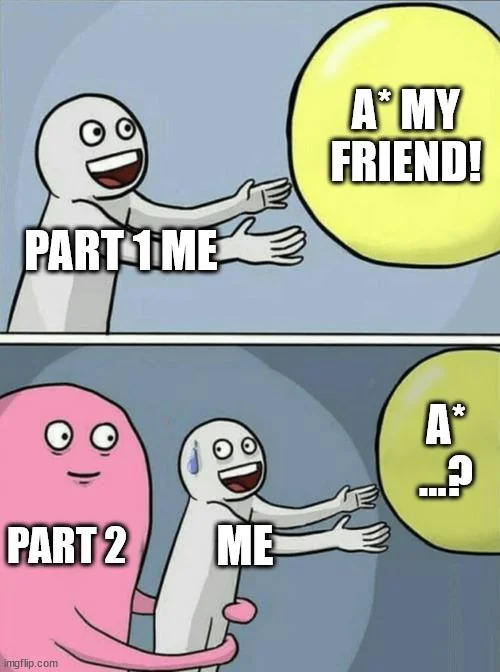Reindeer Olympics

So many puzzles involving 2d grids this year!
Time for an a-maze-ing Reindeer race:
###############
#.......#....E#
#.#.###.#.###.#
#.....#.#...#.#
#.###.#####.#.#
#.#.#.......#.#
#.#.#####.###.#
#...........#.#
###.#.#####.#.#
#...#.....#.#.#
#.#.#.###.#.#.#
#.....#...#.#.#
#.###.#.#.#.#.#
#S..#.....#...#
###############
Start from S and ending at E (duh), the goal here is to optimize on corners, since one movement forward costs 1 point, whereas a rotation costs 1000 points. For example, one of the above maze's best paths has 36 total steps and 7 rotations, reaching a total of 7036 points:
###############
#.......#....E#
#.#.###.#.###^#
#.....#.#...#^#
#.###.#####.#^#
#.#.#.......#^#
#.#.#####.###^#
#..>>>>>>>>v#^#
###^#.#####v#^#
#>>^#.....#v#^#
#^#.#.###.#v#^#
#^....#...#v#^#
#^###.#.#.#v#^#
#S..#.....#>>^#
###############
For once in my life I managed to be intelligent about addressing part 1 in a way that made solving part 2 almost immediate, so I'm going to anticipate the task for part 2 as well before talking about the code.
Essentially, part 1 is about finding the length / score of the best path; part 2 goes: given the optimal path length, calculate how many unique cells are covered by any of the best paths.
For example, keeping the same grid as above, there's a total of three paths with a score of 7036, and 45 unique cells covering each of them:
###############
#.......#....O#
#.#.###.#.###O#
#.....#.#...#O#
#.###.#####.#O#
#.#.#.......#O#
#.#.#####.###O#
#..OOOOOOOOO#O#
###O#O#####O#O#
#OOO#O....#O#O#
#O#O#O###.#O#O#
#OOOOO#...#O#O#
#O###.#.#.#O#O#
#O..#.....#OOO#
###############
To solve both problems at once, we can rather simply create a Dijkstra-like pathfinding algorithm that keeps track of the paths found (as opposed to just returning the shortest path whenever one is found):
- It uses a priority queue to explore paths with the lowest cost first.
- Movement is allowed in the current direction (low cost) or via turns (higher cost).
- Tracks visited states and avoids revisiting with higher costs.
- Stops when the target is reached and all shortest paths are found.
- Returns the lowest cost and the number of unique positions (seats) in the path.
function traverse(grid: Grid, start: Coord, end: Coord) {
const paths = new Set<string>();
let lowest = Infinity;
const scores = new Map<string, number>();
const toVisit = new PriorityQueue<State>((a, b) => a.cost - b.cost);
toVisit.enqueue({
position: start,
direction: Cardinal.EAST,
cost: 0,
path: [],
});
while (toVisit.size() > 0) {
const { position, direction, cost, path } = toVisit.dequeue()!;
const stateKey = `${position.serialize()}:${direction}`;
if (cost > (scores.get(stateKey) ?? Infinity)) continue;
scores.set(stateKey, cost);
if (position.equals(end)) {
if (cost > lowest) break;
path.forEach((coord) => paths.add(coord.serialize()));
lowest = cost;
}
const moves: { dir: Cardinal; moveCost: number }[] = [
{ dir: direction, moveCost: 1 },
{ dir: rotate(direction, Direction.RIGHT), moveCost: 1001 },
{ dir: rotate(direction, Direction.LEFT), moveCost: 1001 },
];
for (const { dir, moveCost } of moves) {
const nextPosition = move(position, dir);
if (grid.get(nextPosition.serialize()) !== '#') {
toVisit.enqueue({
position: nextPosition,
direction: dir,
cost: moveCost + cost,
path: [...path, position],
});
}
}
}
return { lowestScore: lowest, seats: paths.size + 1 };
}